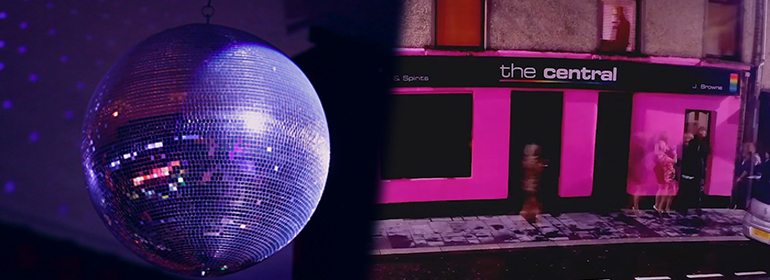The film The Only Gay Bar In The Village explores the gay bar The Central in the town of Strabane, Co. Tyrone
The Only Gay Bar In The Village is a Channel 4, All 4 short film that looks at Strabane, a town in County Tyrone with a population of approximately 18,000. Prior to The Central’s establishment, the town had no gay bars for LGBT people to go to as a safe place where they could be themselves without fear of homophobic, biphobic or transphobic abuse.
The Only Gay Bar in the Village, an All 4 Short, is available to watch at: http://www.All4.com/programmes/the-only-gay-bar-in-the-village

6 Questions With The Director
We interviewed the short film’s director, Vik Patel, a London based producer working in Factual Broadcast TV, about his experience producing it.
1. What drew you to Strabane and The Central Bar?
A journalist friend and I wanted to collaborate on a project about the lives of LGBT people in rural areas. We wanted to explore where their safe haven is, whether it be for a drink, dates or to socialise with other like-minded LGBT people.
In a general way, it feels like it’s easier to be LGBT in a big city like London or Manchester, so what happens to those who aren’t located there? Using that as jumping point, we looked for gay bars in remote areas in Wales, Scotland and then Northern Ireland.
When we first heard about The Central Bar in Strabane, it was from someone based in Belfast who’d heard about it from a friend of a friend.
He wasn’t sure if it was actually real or even a gay bar. It was like a humorous urban legend because our contact didn’t believe Strabane would ever have a gay bar. That cemented the attraction for us.
Eventually we took the plunge and went and filmed over a weekend. C4 saw a cut and asked me to expand it for their All4 platform.
2. A lot of people’s faces are blurred out in the film. Why is that?
The boring answer is: it’s generally standard protocol to blur anyone who’s featured heavily unless they’ve signed a release.
However, there was a lot of discussion with All 4 about the blurring and what it would mean. Ideally, you always try to avoid a sea of blurs but this is a unique situation. During filming, we were thorough with ensuring people were always aware of the camera and consenting.
Once we had begun to edit, we all agreed that the bar was intended to be a safe place where both LGBT and straight customers go, so we didn’t want to inadvertently out anyone who was at the bar discreetly for whatever reason.
3. Did you ever get a figure for how many gay/LGBT people live in Strabane?
No and I don’t think I ever will! Everyone has widely different views on it. I’d hazard a guess at hundreds but I’m very happy to concede I’m wrong.

4. One of the men interviewed indicated he didn’t think having a gay bar in Strabane was a good idea. Did you encounter many people ( LGBT or straight) who shared his opinion while producing The Only Gay Bar In The Village?
From my understanding, the opposition to the bar when it was announced came from a small religious group who threatened to protest it but never did.
From what I’ve heard from some of the LGBT community there, there was initially an element of fear of being openly identified as gay if you were private about it and what that could mean, so that could be where that stemmed from.
As odd as it is, it is a gay bar frequented largely by straight people. I spoke to James ( the bar owner) recently and he mentioned they abandoned a ‘gay only’ night because they couldn’t get enough LGBT people and were turning straight customers away.
5. What was the hardest thing practically about making this documentary?
Initially, we struggled to find people to talk onscreen about their experiences of being LGBT in Strabane. During research chats I’d speak to people with equally positive and distressing stories of coming out in a rural place, but few of them wanted to be filmed.
I suppose it’s the idea of not wanting to publicise distressing moments because they’re still based in Strabane, which I completely understand.
I’m pleased we found a variety of voices and experiences for the final film. They reflect those who still live there and like it, as well as people who moved away to be themselves (in their own words).
Beyond that, filming some of the club nights at the bar proved to be an interesting experience to say the least…
6. What is the one thing you had to cut from the documentary that you would have liked to keep in?
There was loads I wish we could have kept but some of it had to go for pacing and practical reasons.
We cut a discussion about in the closet men who come to the bar, but I couldn’t get anyone to agree to film even with anonymity.
There was also a great discussion about the lack of Grindr action in Strabane that we couldn’t find a good use for, which is a shame as it’s really funny. I think one of them said the closest guy he actually wanted to meet was 14 miles away and he only had a bicycle.
© 2016 GCN (Gay Community News). All rights reserved.



comments. Please sign in to comment.